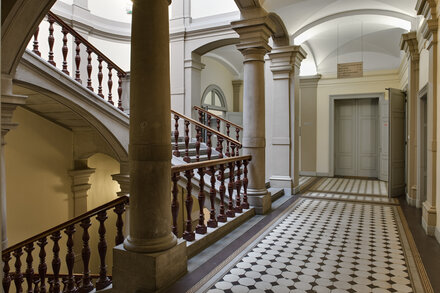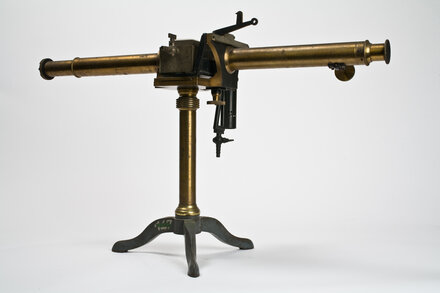Summary
At the Heart of Neustadt, a UNESCO World Heritage Site
A significant portion of the Faculty of Physics & Engineering's activities takes place in the premises of the Physics Institute.
Built in 1882, the institute is one of the buildings forming part of the Imperial University campus. Established by the German Empire after the annexation following the 1871 defeat, this new kind of institution was meant to showcase the modernity of German science. Research and student training were conducted jointly in premises specifically designed for this dual purpose, equipped with laboratories and cutting-edge instrumentation for the time.
The Kaiser Wilhelms Universität campus was constructed at the heart of an urban extension—Neustadt (New City)—which doubled Strasbourg’s size, making it the true capital of the new region of Alsace-Lorraine. An expansion was carried out in the 1960s following plans by B. Bonnet, F. Papillars, J. Brum, and C. Kutkiewicz, connecting the original building to a new structure via a footbridge and featuring a 300-seat amphitheater (Fresnel Amphitheater).
The Faculty remains today at the heart of the historic campus and Neustadt, which was designated a UNESCO World Heritage Site in 2017.
Architecture in the Service of Science
The building’s design, like that of other scientific institutes on the site, was crafted by Berlin architect Hermann Eggert, in close collaboration with the first director of the Physics Institute, August Kundt. Known as the "phenomena hunter," Kundt undertook extensive travels and correspondence to determine the building’s precise functional needs.
Shaped like an "H," the building’s layout separates the east wing—dedicated to the public, with a ground-floor lecture hall and a director’s apartment on the first floor—from the west wing, which houses laboratories.
A central section features a tall, hollow, square tower devoid of ferrous materials, designed for pendulum and gravity experiments. Today, a Foucault pendulum remains on display, a testament to past research activities.
Let’s Look Up…
The technicality of the building is hidden behind the Neo-Renaissance architecture that characterizes the entire imperial campus. The decoration of the institute illustrates the disciplines practiced there. For instance, the pediment of the west wing features allegories of acoustics, electricity, and optics.
Meanwhile, the southern façade is adorned with four panels, each showing two figures of children handling various objects. In reference to Aristotle, these can certainly be seen as allegories of physics' mastery over the elements of nature: earth-matter (with soap bubbles, the artificial creation of the ideal shape that represents the sphere), water (with the water wheel), air (with the kite), and fire (with the magnifying glass).
Today, research activities are carried out by four internationally recognized laboratories, which are presented on our site. The fields range from fundamental research to applied research in physics and engineering. This covers areas from elementary particles to applications in mechanics and electronics, as well as condensed matter, materials, and nanosciences.
Collections of the Physics Institute
Nearly 300 devices and instruments have been preserved to this day: they constitute an instrumental heritage representative of a period in physics, its teaching, and research, corresponding to the great development of experimental physics in the 19th and 20th centuries.
The vast majority of the preserved devices are measuring instruments in electricity and electromagnetism. They allow us to trace the evolution of various measurement techniques, accompanying the research developed over time in the laboratories.
Some of these devices may have been used by Conrad Röntgen (the first Nobel Prize laureate in 1901 for the discovery of X-rays), Ferdinand Braun (Nobel Prize winner in 1909 for his contributions to wireless telegraphy), Pierre Weiss (known for his work on magnetism), or Gustave Ribaud (a specialist in thermodynamics and a member of the Academy of Sciences)—physicists who made significant contributions in their fields and share the commonality of having spent part of their careers in Strasbourg.
Discover the complete inventory of the Institute of Physics collection
Contact for the collection of antique instruments from the Institute of Physics:
Delphine Issenmann, head of the Heritage, Museums, and Collections Department (Jardin des sciences)
Vintage Photos of the Physics Institute in the 1920s
For more information on the history of physics in Strasbourg
Crédits photos : Jardin des sciences – Université de Strasbourg / Service de l’inventaire du patrimoine – Région Grand Est








































